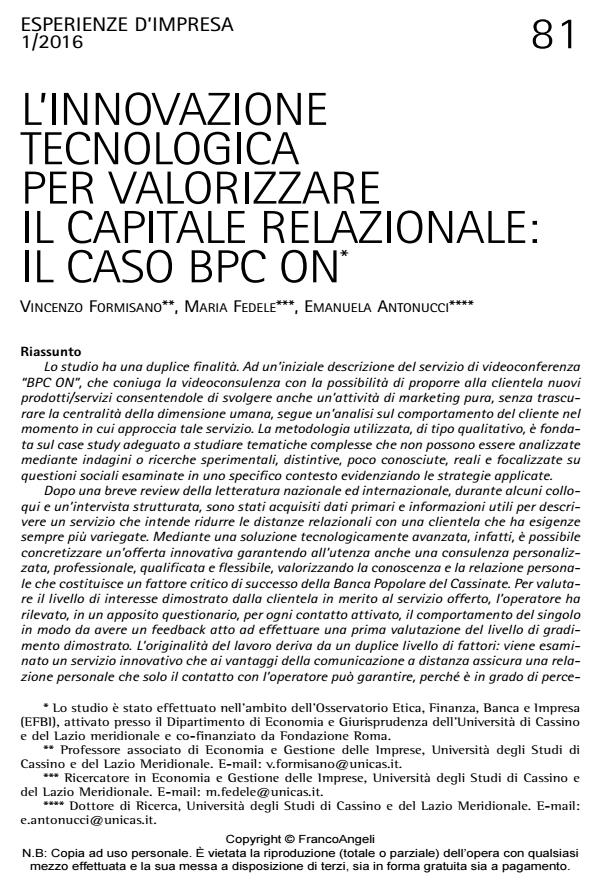L’innovazione tecnologica per valorizzare il capitale relazionale: il caso BPC ON
Journal title ESPERIENZE D'IMPRESA
Author/s Vincenzo Formisano, Maria Fedele, Emanuela Anto
Publishing Year 2018 Issue 2016/1
Language Italian Pages 20 P. 81-100 File size 167 KB
DOI 10.3280/EI2016-001005
DOI is like a bar code for intellectual property: to have more infomation
click here
Below, you can see the article first page
If you want to buy this article in PDF format, you can do it, following the instructions to buy download credits

FrancoAngeli is member of Publishers International Linking Association, Inc (PILA), a not-for-profit association which run the CrossRef service enabling links to and from online scholarly content.
The study has two goals. To an initial description of the videoconferencing service "BPC ON", which combines the video consulting with the possibility of proposing customers new products/services enabling to also carry out a pure marketing activity, without neglecting the centrality of the human dimension, it following an analysis about costumer behavior at the moment in which it approaches such service. The methodology used is qualitative, based on the case study suitable to study complex themes, which can not be analyzed by surveys or experimental research, distinctive, little known, real and focused on social issues examined in a specific context, highlighting the strategies applied. After a brief review of national and international literature, during some meetings and a structured interview, primary data and information have been gathered, useful to describe a service which intends to reduce relational distances with clients having increasing varied needs. Using a solution technologically advanced, in fact, you can realize an innovative offer also providing the user a personal, professional, skilled and flexible consulting, enhancing the knowledge and the personal relationship that is critical for Banca Popolare del Cassinate success. To assess the level of interest shown by customers about the service offered, the operator noted, in a specific questionnaire, for each contact had with customers, his behavior in order to have a feedback to make a first assessment of the level of appreciation shown. The originality of the work derives from a dual level factors: it is considered an innovative service that to the advantages of distance communication ensures a personal relationship that only the contact with the operator can guarantee, because he is able to perceive and understand the real needs of the clients that are identified by the credit card; the service has been activated as well in autonomous self-service stations where you can make pure in/out cash transactions. In such a way the Bank can strengthen its leadership in this kind of service, since it is offered just by a few brokers nationwide and in different ways. From the above considerations it arises the following research question: - How does an innovative technological tool allowing to strengthen the capillarity of a local financial institution in the territory affects the relationship with a selected target customer and operational management? - What is the level of interest shown by the customer in approaching BPC ON?
Keywords: Innovation, banking services, relational approach, territorial proximity.
Vincenzo Formisano, Maria Fedele, Emanuela Anto, L’innovazione tecnologica per valorizzare il capitale relazionale: il caso BPC ON in "ESPERIENZE D'IMPRESA" 1/2016, pp 81-100, DOI: 10.3280/EI2016-001005